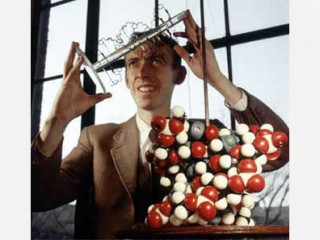
James D. Watson biography
Date of birth : 1928-04-06
Date of death : -
Birthplace : Chicago, Illinois
Nationality : American
Category : Science and Technology
Last modified : 2010-05-26
Credited as : Genetics scientist, Molecular biologist, Nobel Prize for Physiology or Medicine
17 votes so far
In 1947, he received a B.Sc. degree in Zoology. During these years his boyhood interest in bird-watching had matured into a serious desire to learn genetics. This became possible when he received a Fellowship for graduate study in Zoology at Indiana University in Bloomington, where he received his Ph.D. degree in Zoology in 1950. At Indiana, he was deeply influenced both by the geneticists H. J. Muller and T. M. Sonneborn, and by S. E. Luria, the Italian-born microbiologist then on the staff of Indiana's Bacteriology Department. Watson's Ph.D. thesis, done under Luria's able guidance, was a study of the effect of hard X-rays on bacteriophage multiplication.
From September 1950 to September 1951 he spent his first postdoctoral year in Copenhagen as a Merck Fellow of the National Research Council. Part of the year was spent with the biochemist Herman Kalckar, the remainder with the microbiologist Ole Maaløe. Again he worked with bacterial viruses, attempting to study the fate of DNA of infecting virus particles. During the spring of 1951, he went with Kalckar to the Zoological Station at Naples. There at a Symposium, late in May, he met Maurice Wilkins and saw for the first time the X-ray diffraction pattern of crystalline DNA. This greatly stimulated him to change the direction of his research toward the structural chemistry of nucleic acids and proteins. Fortunately this proved possible when Luria, in early August 1951, arranged with John Kendrew for him to work at the Cavendish Laboratory, where he started work in early October 1951.
He soon met Crick and discovered their common interest in solving the DNA structure. They thought it should be possible to correctly guess its structure, given both the experimental evidence at King's College plus careful examination of the possible stereochemical configurations of polynucleotide chains. Their first serious effort, in the late fall of 1951, was unsatisfactory. Their second effort based upon more experimental evidence and better appreciation of the nucleic acid literature, resulted, early in March 1953, in the proposal of the complementary double-helical configuration.
At the same time, he was experimentally investigating the structure of TMV, using X-ray diffraction techniques. His object was to see if its chemical sub-units, earlier revealed by the elegant experiments of Schramm, were helically arranged. This objective was achieved in late June 1952, when use of the Cavendish's newly constructed rotating anode X-ray tubes allowed an unambiguous demonstration of the helical construction of the virus.
From 1953 to 1955, Watson was at the California Institute of Technology as Senior Research Fellow in Biology. There he collaborated with Alexander Rich in X-ray diffraction studies of RNA. In 1955-1956 he was back in the Cavendish, again working with Crick. During this visit they published several papers on the general principles of virus construction.
Since the fall of 1956, he has been a member of the Harvard Biology Department, first as Assistant Professor, then in 1958 as an Associate Professor, and as Professor since 1961. During this interval, his major research interest has been the role of RNA in protein synthesis. Among his collaborators during this period were the Swiss biochemist Alfred Tissières and the French biochemist François Gros. Much experimental evidence supporting the messenger RNA concept was accumulated. His present principal collaborator is the theoretical physicist Walter Gilbert who, as Watson expressed it, «has recently learned the excitement of experimental molecular biology».
The honours that have to come to Watson include: the John Collins Warren Prize of the Massachusetts General Hospital, with Crick in 1959; the Eli Lilly Award in Biochemistry in the same year; the Lasker Award, with Crick and Wilkins in 1960; the Research Corporation Prize, with Crick in 1962; membership of the American Academy of Arts and Sciences and the National Academy of Sciences, and Foreign membership of the Danish Academy of Arts and Sciences. He is also a consultant to the President's Scientific Advisory Committee.
Between 1988 and 1992, Watson was associated with the National Institutes of Health, helping to establish the Human Genome Project. Watson has written many science books, including the seminal textbook The Molecular Biology of the Gene (1965) and his bestselling book The Double Helix (1968) about the DNA structure discovery.
Watson is unmarried. His recreations are bird-watching and walking.
















